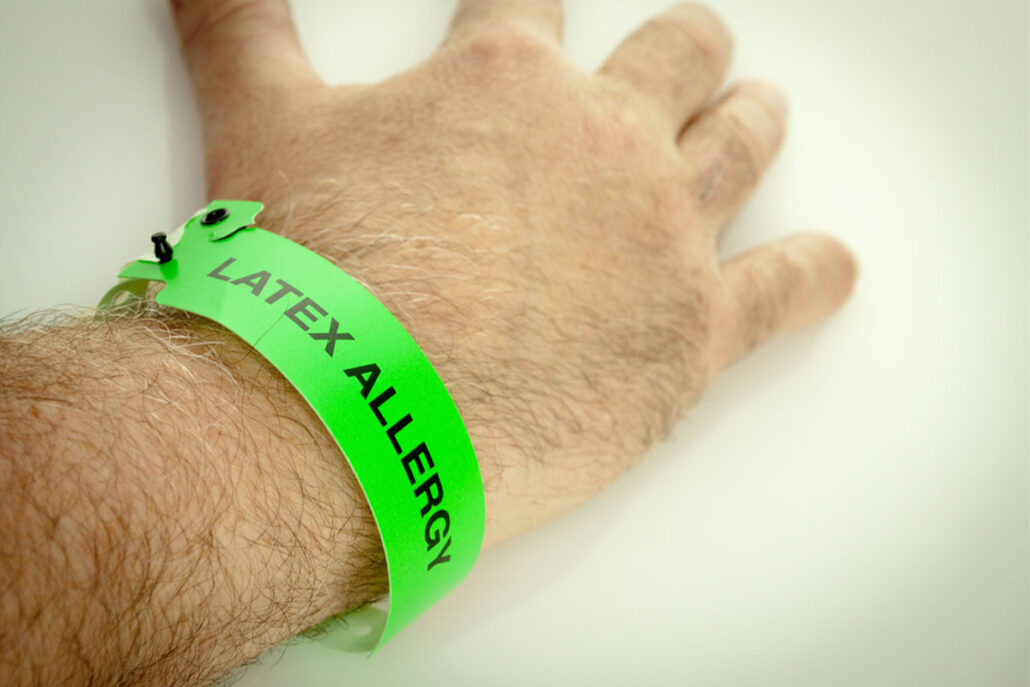Latex allergy is a negative immune reaction to proteins in natural rubber latex from the Hevea brasiliensis tree. It affects many people, especially healthcare workers and those often exposed to latex products. Common symptoms range from mild skin irritations to potentially life-threatening allergic reactions like anaphylactic shock.
To practice effective self-care, individuals with latex allergies must be cautious about their daily products. Identifying and using alternatives like synthetic latex or polyurethane in items like gloves and medical supplies is vital. Allergy skin testing and blood tests confirm the diagnosis, enabling better management in personal and professional settings.
Understanding daily management is critical to maintaining health and preventing allergic reactions.

Identifying Symptoms and Triggers
The symptoms of latex allergy can range from mild to severe and can even be life-threatening, with the most common response being allergic contact dermatitis. Symptoms of anaphylaxis can include difficulty breathing, swelling of the face and throat, a sudden drop in blood pressure, and other systemic reactions. Anaphylaxis requires immediate medical attention to counteract the allergic response, typically in the form of anaphylaxis medications such as an epinephrine pen, oxygen, and IV fluids.
Latex allergy symptoms can include:
- Skin rash, skin redness, hives, or itching
- Scratchy throat, sneezing, runny nose, or watery eyes
- Wheezing, shortness of breath, or coughing
To avoid problematic reactions to latex, skin testing can be a precise method for the diagnosis of latex allergy. Armed with this knowledge, individuals can strengthen their defense against latex allergies and take a proactive approach to avoid direct contact with products that contain this material.
Creating a Latex-Free Environment
People with latex allergies must foster a rigorous approach in their selection of materials so that their living and working environments are purged of latex allergens. This involves scrutinizing household and workplace items, from elastic bandages to rubber toys, to ensure they don’t contain any natural latex. Often, safe alternatives are available to replace these items.
To ensure safety, one must meticulously create a latex-free environment. To do this:
- Replace latex household items with alternatives, like silicone or vinyl.
- Choose synthetic rubber products, such as neoprene, nitrile, or polyurethane, for personal items.
- Communicate with healthcare providers about using latex-free medical devices.

For example, nitrile gloves and polyurethane bandages can replace their latex counterparts without compromising functionality. Being meticulous in this area significantly mitigates the risk of allergic reactions.
Communicating Your Allergy to Others
Communicating about your allergy with your friends and place of work is very important so that they can adopt practices that will help you avoid exposure to latex. Likewise, explicit communication with healthcare workers—due to their frequent skin washing and exposure to rubber—can circumvent unnecessary risks.
Effective communication about your latex allergy is indispensable to your safety. Be sure to:
- Inform health care providers, dentists, and emergency responders about your allergy.
- Discuss your needs with employers to ensure a latex-safe work environment.
- Educate friends and family to prevent inadvertent latex exposure at home or during social events.
By sharing this vital information, you empower those around you to make informed choices that contribute to your well-being and minimize the risk of latex-related emergencies.
Managing Allergic Reactions
Prompt recognition and management of latex allergy reactions are vital for those experiencing contact dermatitis or more severe reactions.
However, the most critical step occurs post-reaction: thoroughly analyzing and identifying the exposure source. Ideally, this will be done with a board-certified healthcare professional who can determine the proper protocol to use after latex exposure.
Even with diligent avoidance, accidental contact with latex may occur. Be prepared to manage allergic reactions in the following ways:
- For mild reactions, have over-the-counter or prescribed antihistamines readily available.
- For skin reactions, use hydrocortisone cream to alleviate irritation.
- Recognize the symptoms of anaphylaxis and always carry an epinephrine auto-injector for prompt treatment.
For individuals with diagnosed allergies to latex, immunotherapy could be a suitable treatment option. This approach involves gradually administering small amounts of latex protein into the patient’s system through a series of injections. With time, these injections work to desensitize the immune system to the allergen, diminishing the severity of allergic reactions and offering relief from symptoms associated with latex allergy.
For emergencies, seek immediate medical attention and use an epinephrine auto-injector if available.
Self-Care Practices for Daily Management
Daily self-care practices can help to avoid the repercussions of a reaction to latex. Some daily self-care practices that aid in managing latex allergies are:
- Wearing medical alert bracelets to rapidly communicate your allergy in emergencies.
- Vigilantly reviewing product labels to confirm they are latex-free before purchasing.
- Using alternative materials to latex products
- Nurturing skin health through frequent skin washing with mild soap and the use of barrier creams.
While dietary practices cannot directly prevent or treat latex allergy symptoms, some individuals with latex allergies may experience cross-reactivity with certain foods. This is known as latex-fruit syndrome, where proteins in certain fruits and vegetables resemble those found in latex, leading to allergic reactions in some individuals.
Common culprits of cross-reaction include bananas, avocados, kiwi, chestnuts, and certain stone fruits like peaches and cherries. If you suspect cross-reactivity between latex and certain foods, consult with an allergist or immunologist for specific latex allergy testing. Identifying cross-reactive foods can help in creating a personalized dietary plan.
Conclusion: Taking Charge of Your Latex Allergy Management Through Self-Care
Recognizing the common symptoms of latex allergy, such as skin reactions minutes after contact or more severe symptoms affecting the nasal allergy and mucous membranes, is essential for timely intervention.
Effectively navigating a latex allergy requires a continuous blend of self-care, vigilance, environmental control, and open communication. Embracing this multidimensional approach is vital to safeguard against unexpected reactions and empower individuals facing potential latex exposure.
There is help available to support individuals with latex allergies. One reputable organization is the Asthma and Allergy Foundation of America (AAFA), a patient advocacy organization dedicated to improving the quality of life for individuals with asthma and allergies, including latex allergies.
For expert guidance and support in managing latex allergies, consider contacting Penn Medicine Becker ENT & Allergy in NJ and PA. Their team can offer personalized strategies and comprehensive care to help you stay informed, prepared, and communicative to manage your latex allergy effectively.

